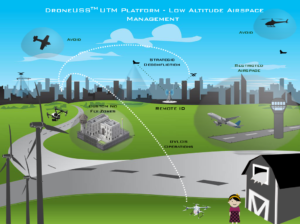
UTM is big. It’s complex. Many of the participants in UTM testing are the giants of a commercial drone industry: Amazon, Google, companies need to understand UTM in order to coordinate the huge efforts of large scale delivery and Fortune 100 drone implementations. They’re developing USS that will work for their operations. But the brains of the UTM system on 2 out of 6 FAA tests – – was a small startup we’ve written about before, ANRA Technologies.
ANRA gave us our first look inside of the UTM project. Their founder, Amit Ganjoo, has a background in aviation and enterprise. He has worked previously with DoD and his company has had a Space Act Agreement with NASA to support its UTM program for a few years now. He is actively working with NASA UTM team lead by Parimal Kopardeker (PK,) the leader of the project. He thinks big scale.
There are multiple parts to UTM. Tracking and ID, remote sensing and regulation are all critical pieces of the framework. But as VC Firm Loup Ventures describes in their UTM Deep Dive research paper, “The core functionality of a UTM system will be managed by a UAS Service Supplier (USS)… The USS would be the central hub, where all other stakeholders (drone operators, hobbyists, air traffic control, law enforcement, and the public) come for situational awareness regarding unmanned aircrafts. USS will also provide crucial information for commercial drone operators, which include airspace authorization, UAS identification, real-time aircraft tracking, conflict advisors, and geo-fencing.”
That’s a tough job description. But the paper goes further to define the top player in the space: “The ideal USS will provide an independent, highly automated and scalable system that will manage and monitor drone flights, as well as factor in inputs from external sources such as terrain, weather, air traffic control, making this data available to all commercial drone operators or service providers. In addition, the USS will send notifications to external stakeholders like public safety and state agencies.”
ANRA’s DroneUSS works, and will work for everyone – it’s designed to be a neutral player, licensed to other providers or companies. It offers and extensive set of APIs for inbound and outgoing integrations with external systems and stakeholders. While “deconfliction” – the UTM euphemism for “avoiding a crash” – is handled by most systems theoretically, within the system, ANRA’s system is designed to handle both cooperative and non cooperative assets and is capable of performing vehicle to vehicle deconfliction with multiple sensors and sense-and-avoid technology: an important redundancy.
There won’t be one single provider or one single system when UTM is implemented. Small systems will scale with the industry. But having that scalability and having extensive open interfaces, which ANRA views as one of its differentiators, is critical: “This has to scale, it’s not building a website or a mobile app,” says Ganjoo.
Here in the U.S., UTM testing is performed by a cadre of technology partners under the guidance of NASA and the FAA. During these tests – most recently, the Technical Capability Level (TCL) 3 tests – scenarios of drone missions are enacted. The tests take multiple partners to complete.
There are the aircraft providers. There are the network providers – communications giants like Verizon and ATT are on NASA’s list of partners. There are sensors, AI technology, and regulations experts. All of them have a part to play; an important one. But the player drone operators are likely to experience first is the USS, the glue that holds it all together: and that might well be ANRA.